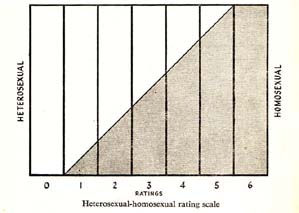Not-Quite-Bisexual Is Nothing New
The concept of a fluid sexual orientation has been around for decades.
On CNN today, we also discussed bisexuality. It is a commonly accepted idea in sexology that people are not always 100% homosexual or 100% heterosexual. In fact, sixty years ago, Alfred Kinsey conceptualized this in his landmark 1948 book Sexual Behavior in the Human Male where he presented his scale of sexual orientation. Kinsey informed us to not characterize people as either gay or straight, but rather as individuals who have certain amounts of heterosexual and homosexual experiences, thoughts, fantasies, attractions and desires. He also explained that sexual orientation should take into account past, present, and future ideas about one’s sexuality (not just behaviors), and that it may evolve or change throughout one’s life. The Kinsey Scale for Sexual Orientation is still the most used source for distinguishing different sexual orientations by describing the range of possibilities. The scale goes from 0 “exclusively heterosexual” to 6 “exclusively homosexual,” with bisexual at 3. Most people would not fit as either a 0 or 6, because most people have at least some occasional fantasies about both genders. A woman who has sex with her boyfriend, but also has fantasies about girls and kissed a girl (“and liked it” as Katy Perry sings) would probably be a 1 on the Kinsey Scale.

- Kinsey Scale
The Kinsey Scale for Sexual Orientation, Scanned from my first edition copy: Kinsey, A., Pomeroy, W., Martin, C.. (1948) Sexual Behavior in the Human Male. Philadelphia, PA: W. B. Saunders.
0- Exclusively heterosexual with no homosexual
1- Predominantly heterosexual, only incidentally homosexual
2- Predominantly heterosexual, but more than incidentally homosexual
3- Equally heterosexual and homosexual
4- Predominantly homosexual, but more than incidentally heterosexual
5- Predominantly homosexual, only incidentally heterosexual
6- Exclusively homosexual
Posted by: Dr. Sari Locker
Tags: bisexuality, fluid sexual orientatation, Kinsey Scale, sexual orientation












